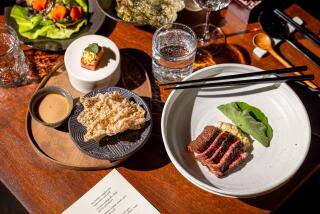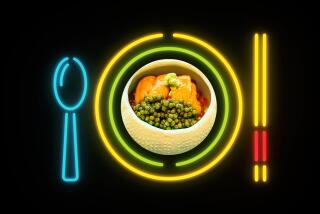Price May Be Unpalatable, but China Looks Good Enough to Eat
- Share via
If we’re truly honest with ourselves, we’ll realize sooner or later that the best meal we’ll ever know will come in a little cardboard box and be eaten in the cheap seats on a balmy Saturday in the middle of a tight pennant race. The cardboard box will be kept after the hot dog, drink and Cracker Jack are polished off, and will be used as a hat.
Up one notch on the culinary fashion ladder is the paper plate (not Styrofoam; items that won’t biodegrade until the next Democratic presidential landslide are out of fashion). You take it with you to the Hollywood Bowl or Irvine Meadows in July, fill it up with potato salad and barbecued anything from Burrell’s Rib Cage and set it neatly in your lap when the time comes to applaud Beethoven and the fireworks.
The third and highest rung of dinnerware that can actually be said to be fun is the Greek plate, which is quite a plain piece of crockery. But then, how fancy does it have to look to be flung to the floor with a splendid crash and a great communal Opa !
Everything else (with the possible exception of the plain white, slightly recessed pasta plate--the most utilitarian and unassumingly elegant piece of dinnerware ever invented) is mostly for show. And this is all to the good if not, strictly speaking, fun.
It’s always a treat to eat off magnificent plates for two reasons: first, they look terrific even with nothing is on them, and second, it’s a cinch they’re going to eventually be filled up with top-drawer chow.
The inevitable downside: This stuff costs a lot.
The mitigating circumstance: if you use it regularly, you get your money’s worth.
Take Tiffany’s new line of china, for instance. It’s about as elegant as American china gets. It could make Brussels sprouts and lima beans taste good. Introduced this month, it was designed to go with five settings of classic Tiffany sterling silverware, with patterns dating back as far as 1871.
A few dozen local arts supporters--The Visionaries from the Newport Harbor Art Museum--got a look at the five patterns at a recent luncheon at the Center Club in Costa Mesa. And some of the descriptions of the place settings, written by Tiffany & Co.’s head of display, Fred Chuang, indicate just how much the company considers the china to be platforms for food and how much they think it really ought to be buried with a Pharaoh.
Of the Audubon pattern, introduced in the flatware in 1871: “In order not to distract from the delicacy of the tableware design, the basic and universal white egg was chosen as the key decor element.”
Of the table centerpiece that went with the Shell and Thread pattern, introduced in 1905: “A white sand beach, sown with exotic shells and coral, was further peppered with pearls, diamonds and precious metals fashioned into more shells, shrimp, and one delicate sea horse of gold and diamonds.”
Of the Century pattern, introduced in 1937 to celebrate Tiffany’s 100th anniversary: “The Century china incorporates grays, cream and gold in a geometric pattern with Deco and contemporary pertinence.”
Yes, he loves the stuff.
And why not? If you ate off this china, say, three times a week, you’d feel like King Farouk.
So the question begs: Why not do it?
Sure. Think of it as an investment in therapeutic smugness. Given a choice, would you rather come home to a fine dinner nestling on a geometric pattern with Deco and contemporary pertinence or the usual microwave glop slathered across dishwasher-safe, microwave-safe, nuclear holocaust-safe, couldn’t-crack-it-with-a-Patriot-missile K mart synthetic?
You over there with your arms splayed across the front of your china cabinet--yes, I hear you screaming. You’re the one who wouldn’t set your table with the good stuff unless the entire British royal family showed up, and maybe not even then.
Puritanical denial. The Tiffany folks think their tableware is art, too, but they still manage to force themselves to load it up with food. A Ferrari Daytona is art, but anyone with a soul would rather eat worms than pass up a chance to lead foot it to Carmel.
Besides, if you get used to regularly eating off something that uses an egg as a “decor element” you’ll likely start cooking and eating better. There’s no denying that Tiffany plates would hugely improve the appearance of anything in a Dinty Moore can, but wouldn’t an insouciant little coq au vin with parsleyed new potatoes and glazed carrots look better?
And as long as we’re talking about decor elements, who’s to say that a table set with fine china and silver isn’t an interior design statement? It almost forces the rest of the house to look good.
Yes, you’re going to pay for it. Among the five-piece china settings, the prices range from $260 to $290 per setting. The flatware goes for between $400 to $450 per setting.
But measure this against the lifetime of satisfying clanking noises you’ll be making as you set your Century silver down on your Century plate after yet another evening--the third this week--of the finest in contemporary and pertinent grub.
If you’re thinking of Greek food, though, go out for it. Tiffany plates are known for many things, but aerodynamics isn’t one of them.
More to Read
Eat your way across L.A.
Get our weekly Tasting Notes newsletter for reviews, news and more.
You may occasionally receive promotional content from the Los Angeles Times.










